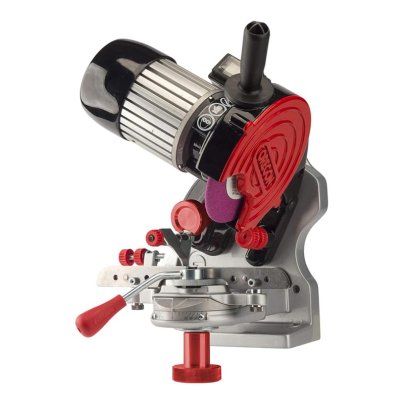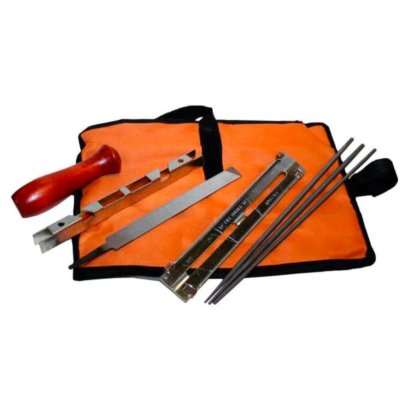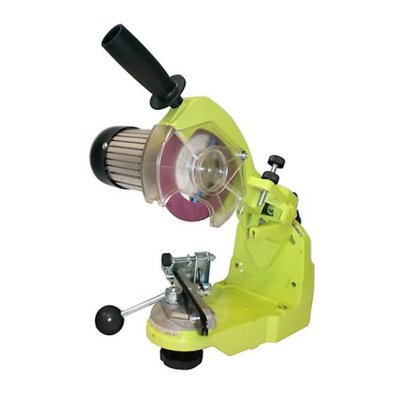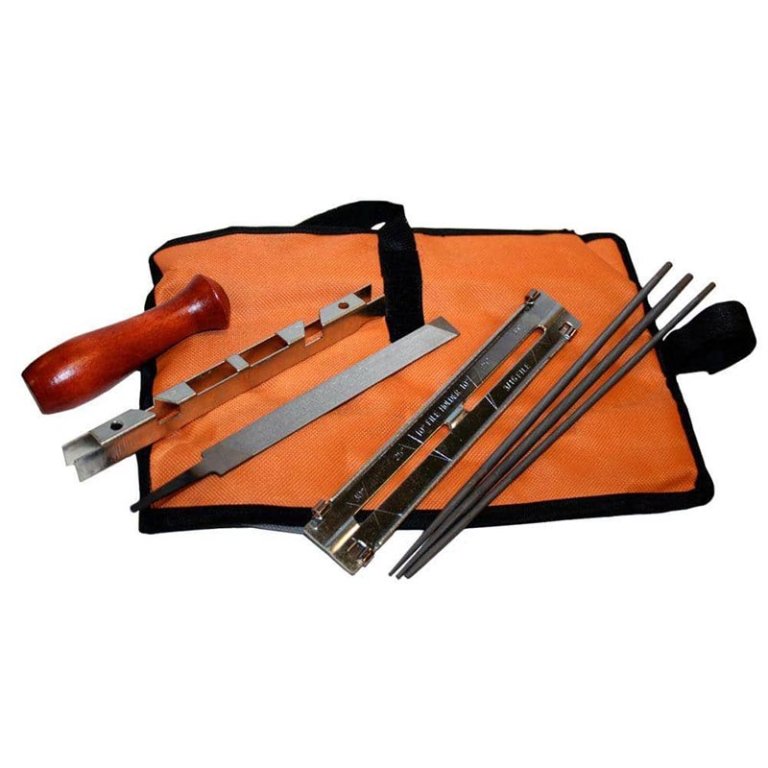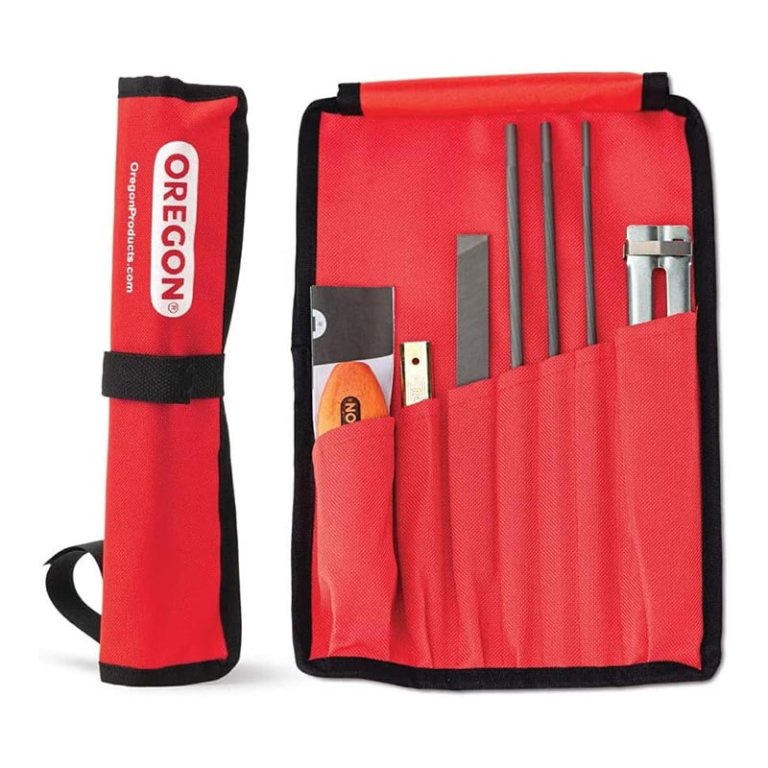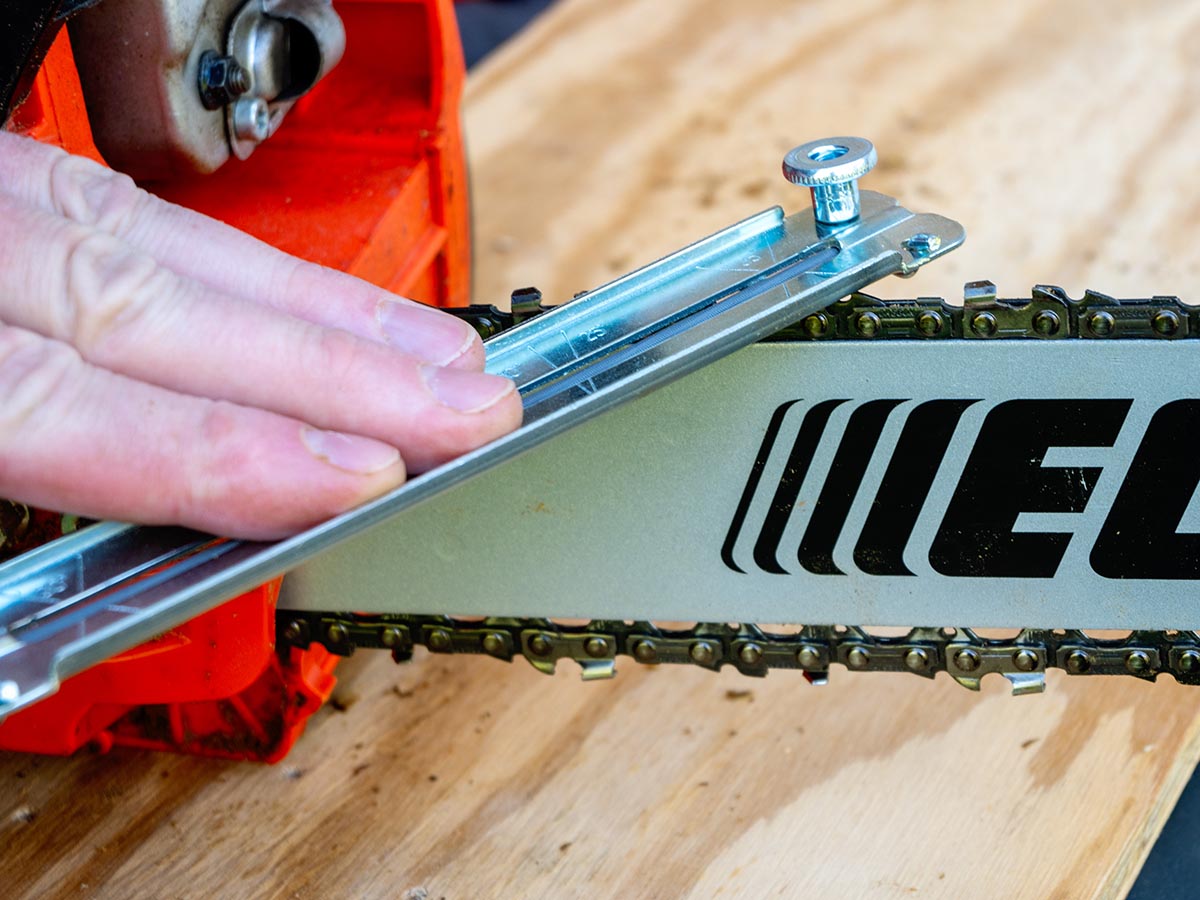
We may earn revenue from the products available on this page and participate in affiliate programs. Learn More ›
A sharp chainsaw makes cleaner, faster cuts with less effort. It’s easier on the saw’s engine, safer for the operator, and healthier for the trees being pruned. To keep their saw chains in safe and efficient working condition, experienced operators use a two-step approach. They use either a small, portable electric chainsaw sharpener or a set of files for quick touch-ups in the field. Back at the shop, they use a benchtop chainsaw blade sharpener for precise saw chain reconditioning.
We tested the best chainsaw sharpeners from both of these categories in order to find the top tools and the ideal two-step combo for serious DIYers and weekend warriors. Our favorite is the Oregon 410-120 120V Bench Grinder Chain Sharpener thanks to its speed and precision. It’s also one of the most versatile models on the market, mounting to either a workbench or a wall. Read on to discover our other top picks and find the best chainsaw sharpener for your needs.
- BEST OVERALL: Oregon 410-120 120V Bench Grinder Chain Sharpener
↓ Jump to Review - BEST BANG FOR THE BUCK: PowerCare 8-Piece Field Kit
↓ Jump to Review - BEST BENCH-MOUNTED: Timber Tuff Bench-Mount Electric Chain Sharpener
↓ Jump to Review - BEST BAR-MOUNTED: Granberg International Bar-Mounted File Guide System
↓ Jump to Review - BEST MANUAL KIT: Echo Saw Chain Sharpening Kit
↓ Jump to Review - BEST HANDHELD ELECTRIC: Oregon 575214 12V Sure Sharp Handheld Chain Grinder
↓ Jump to Review - BEST CHAINSAW FILE SET: Oregon 617067 Universal Chainsaw Field Sharpening Kit
↓ Jump to Review - BEST CHAINSAW FILE JIG: Stihl 2-in-1 Filing Guide
↓ Jump to Review
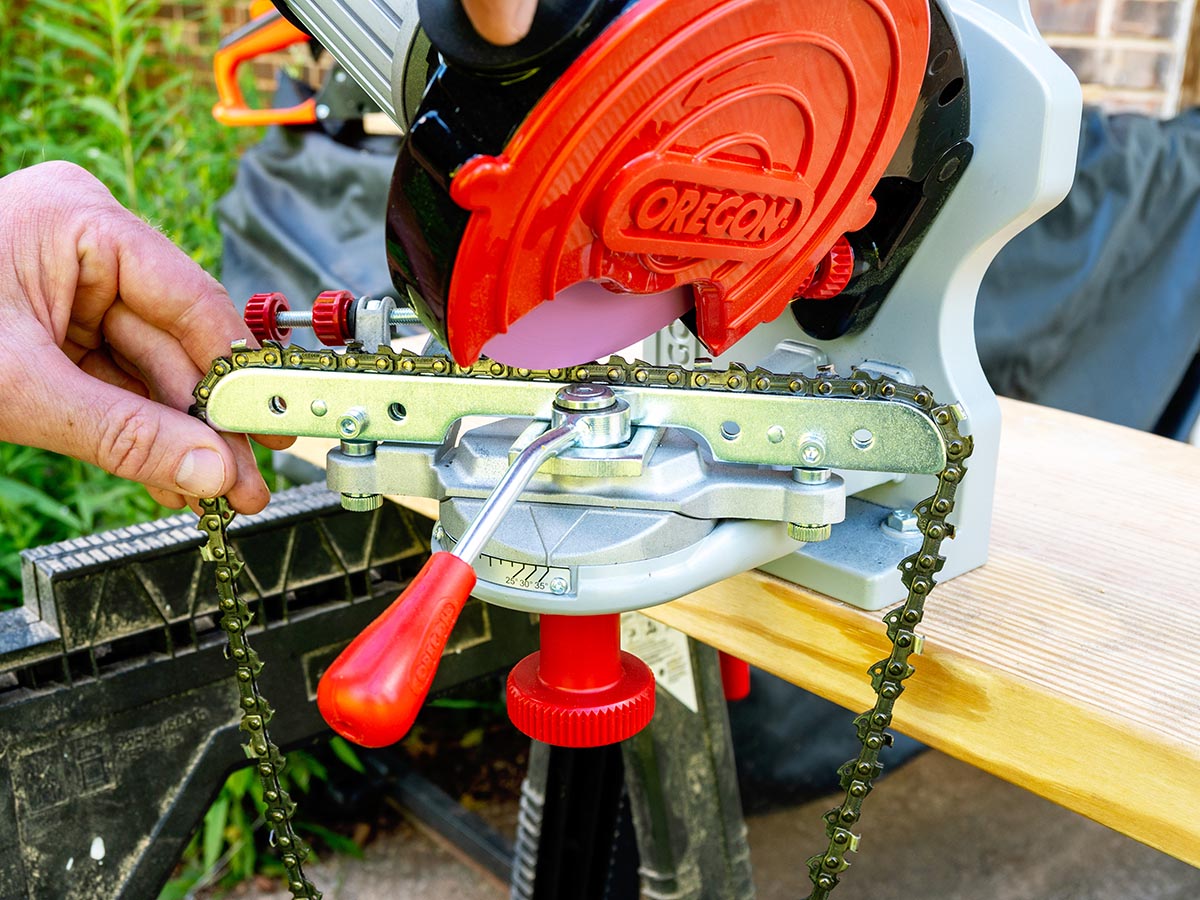
Before You Buy a Chainsaw Sharpener
If you only use your chainsaw a few times a year for seasonal chores, you might be best served with a set of files or a handheld electric sharpener. No need to waste money or storage space on a benchtop unit when a hardware store can professionally sharpen your saw chain for less than $10. Benchtop models make more economic sense for those who consistently use their saws year round, or for exceptionally high seasonal usage. When a trip to town disrupts critical production time, it’s probably best to get your own bench chain sharpener.
Whether you are shopping for a portable sharpening system or a bench-mounted unit, it’s important to match the equipment to your saw. Read your chainsaw operator’s manual or look up your saw model online to find out what size file or grinding wheel you should use. Most of the chainsaws that shoppers buy from big box stores require one of three file or grinder thicknesses: 5/32, 3/16, or 7/32. With mini chainsaws or larger saws, the required sizes become even more diverse. Using the wrong size sharpener will ruin your saw chain.
If you’re still in the market for a chainsaw or are looking to upgrade from an old model, check out our ranking of the best chainsaws.
How We Tested the Best Chainsaw Sharpeners
The chainsaw sharpening equipment we tested fit into two different categories with unique purposes. Portable chainsaw sharpeners are designed for touch-ups while the chain is still on the saw, while benchtop chainsaw sharpeners require the chain to be removed for precision grinding. Our tests and scoring system reflected those differences.
We started with several dull 26-tooth ⅜ P-pitch saw chains. Following the manufacturers’ instructions, we assembled the sharpeners and adjusted them for our chains. We inspected and noted the condition of each chain before sharpening and how quickly and efficiently the sharpeners did their job. After sharpening, we tested the sharpness with five cuts through a 10-inch-diameter green maple log, followed by 20 cuts through a 12-inch seasoned oak log.
While ease of use was one of our scoring factors, the highest marks went to the models that produced fast, precise, consistent results even if setup and adjustments were a little more complicated. We also added bonus points for features that made these sharpeners more convenient to transport or store when they are not in use.
| Testing Stats | |
| Products tested: | 8 |
| Hours spent testing: | 10 |
| Tests performed: | 6 |
| Price range: | $20 to $220 |
Our Top Picks
In our test group, we included a cross section of the most effective sharpening systems for a variety of scenarios. The following reviews highlight each sharpener’s unique characteristics and our observations from testing. Regardless of your budget or work patterns, one of these models could be the best chainsaw sharpener to keep your saw in tip-top shape.
Best Overall
Oregon 410-120 120V Bench Grinder Chain Sharpener
Pros
- Comes with 3 grinding wheels, a dressing stone, and a grinding-wheel gauge
- Manual handle and chain clamping vise are built-in for securing links
- Built-in light enhances visibility while cutting; suitable for precise sharpening
- Bolts included for mounting; suitable for installing as a permanent fixture in the workshop
Cons
- Higher price for speedy precision sharpening and premium quality
Product Specs
- Type: Electric
- Compatible pitches: ¼-inch, ⅜-inch low-profile, 0.325-inch, full-profile ⅜-inch, and 0.404-inch pitches
- Mountable: Yes
Our Ratings: Setup 4/5; Ease of Use 4/5; Sharpening 5/5; Quality 5/5; Value 4.7/5
Offering standout versatility, Oregon’s chain grinder mounts either on a workshop wall or to a workbench, where it sharpens any chain pitch, including the most widely used ¼-inch, ⅜-inch low-profile, 0.325-inch, full-profile ⅜-inch, and 0.404-inch pitches. The 2.1-amp motor turns the grinding wheel at 3,500 revolutions per minute (RPM).
This built-tough, best-in-class sharpener features a manual lock for securing the cutting links, and it comes with three grinding wheels, a dressing stone, and a plastic grinding wheel gauge. The sharpener can be mounted on a bench or wall with two bolts (not included). There’s also a built-in LED work light for added visibility.
We awarded this Oregon chain sharpener the top spot because of its speed, precision, and versatility. After assembling the unit, we adjusted the base pivot, cutter stop, head tilt, and depth stop. All of the adjustments worked smoothly and flawlessly, and they held securely within tight tolerances. The head adjustment knobs were placed on the front of the plate so the unit could conveniently be mounted on a wall. The only minor inconveniences with this setup are the small adjustment knob diameters—mainly for the head tilt and depth stop—and having to reach “through” the grinder head to access them.
Although bench mounting is a popular configuration, we preferred the wall-mount setup. It didn’t take up bench space, and the higher working height gave us better visibility without forcing us to bend. It also made for a more convenient workstation as it allowed us to hang our detangled chains within easy reach as they waited for sharpening, and again after sharpening, instead of dealing with tangled piles on the bench.
Read our full review: Oregon 410-120 120V Bench Grinder Chain Sharpener
Get the Oregon 410-120 chainsaw sharpener at Amazon, Walmart, Northern Tool + Equipment, or American Forestry.
Best Bang for the Buck
PowerCare 8-Piece Field Kit
Pros
- 8-piece kit includes files for 6 different chain pitches and depth guide adjustments
- Included hardwood handle is compatible with all 4 files for space-saving convenience
- Chisel tooth guide and depth gauge included with purchase for sharpening accuracy
- Hook-and-loop tool case included for safe storage and portability
Cons
- Handheld sharpening system is less precise than mounted types
- The files cut less aggressively than others we tested, so it takes more strokes to sharpen
Product Specs
- Type: Manual
- Compatible pitches: ¼-inch, ⅜-inch low-profile, 0.325-inch low-profile, full-profile 0.325-inch, full-profile ⅜-inch, and 0.404-inch pitches
- Mountable: No
Our Ratings: Setup 5/5; Ease of Use 5/5; Sharpening 4/5; Quality 4/5; Value 4.7/5
For a budget-friendly, portable chain sharpener kit that is both easy to use and effective, the PowerCare file set provides everything you need to sharpen one or multiple chainsaws. Equipped with 5/32-inch, 3/16-inch, and 7/32-inch round files, it works for a wide range of chain pitches. The eight-piece kit also includes a hardwood handle, round file guide, flat file, a depth gauge and a nylon carrying case.
This sharpening chainsaw kit is made to be carried around in your tool box or pocket in order to keep the chain in relatively good shape between professional sharpenings. Its carrying case features a fold-over flap to keep the pieces from sliding out, plus a hook-and-loop fastener.
Our ⅜ P pitch chain posed no real challenge for this kit. We installed the 5/32-inch round file into the file holder, inserted the file base into the handle, and began filing within a minute. It took about 5 minutes to sharpen all of the cutters, at five file strokes each. The reference angles on the file guide made it easy to stay on target. After we finished with the cutters, we used the included gauge and flat file to adjust the chain’s depth gauges (sometimes called rakers).
The files in this chainsaw sharpening kit felt a bit less aggressive than those in the Oregon and Echo manual filing kits we tested, but they did a good job nonetheless. It was helpful to have all three round file sizes, and therefore only need a single kit for all of our chainsaws. The wooden handle was comfortable to hold and held the files securely. This was a convenient and effective kit at a good price.
Get the PowerCare chainsaw sharpener at The Home Depot.
Best Bench-Mounted
Timber Tuff Bench-Mount Electric Chain Sharpener
Pros
- Precision sharpening system compatible with most chain gauges and pitches
- Compound-adjustable chisel angle with positive depth stops for repeatable accuracy
- Includes ⅛-, 3/16-, and ¼-inch grinding wheels; dressing stone; and profile guide
- Built-in 15-watt work light for improved visibility and accuracy
Cons
- Popular 5/32 grinding wheel size is not included (available separately)
- Considerable setup time to assemble the unit and properly adjust the angles
Product Specs
- Type: Electric
- Compatible pitches: ¼-inch to ¾-inch pitches
- Mountable: Yes
Our Ratings: Setup 4/5; Ease of Use 4/5; Sharpening 5/5; Quality 4.5/5; Value 4.3/5
A wall- or bench-mounted chainsaw sharpener saves time and money spent on professional sharpening and delivers similar results. The Timber Tuff electric chain sharpener is one of the most affordable and effective mountable models available.
This sharpener comes with ⅛-, 3/16-, and ¼-inch grinding wheels to keep chains with ¼-inch to ¾-inch pitches cutting like new. The 2.1-amp motor turns the grinding wheel at 3,600 RPM for rapid sharpening. A built-in 15-watt work light aids visibility, and thermal overload protection adds another layer of safety.
Although the mounting holes are configured for either bench or wall mounting, in testing we found that the wall-mount would be tricky since the head tilt tightening knob is located at the rear of the unit. We opted for a bench mount, which worked perfectly. After assembling the grinder, we installed our saw chain and noted that the base was extremely difficult to pivot. We disassembled and lubricated the part but could not get it to pivot smoothly. Maybe that will change with a little wear.
After setting the base angle, cutter stop, head angle, and grinding height stop, we gave it a go. The chain moved smoothly across the vice and locked securely with the lever lock. It only took about 2 minutes to sharpen all of the cutters, including time to reset the base angle when switching from right cutters to left cutters. Lastly, we spent another 5 minutes changing to the ¼-inch grinding wheel and dressing it so that we could adjust depth gauges.
As one of the least expensive bench grinders for chainsaw sharpening, the Timber Tuff electric sharpener is a real bargain. A couple of minor details keep it from the best overall spot, but we would overlook those issues and take the savings.
Get the Timber Tuff chainsaw sharpener at Tractor Supply Co., Walmart, Northern Tool + Equipment, or Blain’s Farm & Fleet.
Best Bar-Mounted
Granberg International Bar-Mounted File Guide System
Pros
- Highly precise filing jig for maintaining sharp edges and identical tooth angles
- Compact and lightweight sharpening system conveniently fits in a tool box
- Manual sharpener can be used anywhere, as often as needed, while conserving fuel
Cons
- Cumbersome tool when used on smaller bars and shorter chain pitches
- Files are sold separately
Product Specs
- Type: Manual
- Compatible pitches: All (files sold separately)
- Mountable: Yes
Our Ratings: Setup 4/5; Ease of Use 5/5; Sharpening 5/5; Quality 4/5; Value 4.7/5
When it comes to manual chainsaw sharpeners, most kits include a simple filing guide with an embossed reference angle that leaves plenty of room for errors. But the Granberg International bar-mounted chainsaw sharpener guides the file in exactly the same position for every stroke. It sharpens more accurately and preserves the chain’s working life, which saves you time, effort, and money.
The sharpening jig is ruggedly made of cast aluminum and zinc-plated steel to withstand all kinds of weather. It is compatible with any size round file and adjusts to any cutter angle, so it works with any saw. The system consists of a file holder that secures the round file at the desired angle and a bar mounting bracket that supports the file holder. In addition to sharpening cutters, it can hold a flat file used to lower the chain’s depth gauges.
While we were able to achieve incredibly accurate results with this tool, it felt like overkill for our small chainsaw. For comparison, it only took about 5 minutes to sharpen our saw with a conventional freehand round file kit, but it took a couple minutes longer to use this system. The difference is mainly due to the time it took to set up the clamp and adjust the angles. Three separate settings are required for right cutters, left cutters, and depth gauges. For larger saws, especially in tough cutting conditions where precision is key to transferring maximum power from the engine to the cut, this jig would really stand out.
Get the Granberg International chainsaw sharpener at Amazon, Northern Tool + Equipment, TreeStuff, or Bailey’s.
Best Manual Kit
Echo Saw Chain Sharpening Kit
Pros
- All-in-one kit includes everything needed to sharpen a ⅜-inch low-profile chain
- Includes file guide and depth gauge for accurate sharpening
- Includes a hook-and-loop carry case to keep kit organized in storage and transport
- High-quality files cut aggressively, requiring fewer passes to sharpen
Cons
- This kit only includes 5/32 round files, so chain compatibility is limited
- Higher price than similar kits that include multiple round file sizes
Product Specs
- Type: Manual
- Compatible pitches: ⅜-inch low-profile pitch
- Mountable: No
Our Ratings: Setup 5/5; Ease of Use 5/5; Sharpening 4/5; Quality 5/5; Value 4.3/5
For those with only one chainsaw, or multiple saws with the same pitch, a single round file size is all you need. The Echo saw chain sharpening kit could be the best choice. It comes with a filing guide, depth gauge tool, soft-grip handle, flat file, and two 5/32-inch round files. The kit is packed in a handy nylon case with a hook-and-loop closure.
In our tests, the Echo kit files seemed to work more aggressively than those in the PowerCare kit. The Echo files accomplished in three strokes what the PowerCare files did in five. But Echo’s higher price might make the labor savings less attractive to some.
The other standout feature of this kit was the rubberized handle. It felt more comfortable and controllable than the hardwood handles that came with similar kits, but it might be less durable. We noted that the plastic flanges meant to provide file-holding friction in the handle socket were a bit torn up after the first use, but we didn’t have problems with the file slipping. Echo offers other file kit models with different file sizes for different chain pitches.
Get the Echo chainsaw sharpener at Amazon, Walmart, or Small Engines Pro Dealer.
Best Handheld Electric
Oregon 575214 12V Sure Sharp Handheld Chain Grinder
Pros
- 25,000 RPM handheld electric grinder sharpens dull saw teeth fast
- Includes 5/32, 3/16, and 7/32 grinding bits, compatible with most chainsaws
- Kit comes with battery clamps and a 12-volt car outlet adaptor
- Lightweight, portable grinder easily fits in a tool box
Cons
- Does not include storage for extra grinding bits, wrench, and adaptor
- On-tool angle guide is helpful, but less precise than mounted guide
Product Specs
- Type: Electric
- Compatible pitches: ¼-inch, ⅜-inch low-profile, 0.325-inch, ⅜-inch, 0.404-inch pitches
- Mountable: No
Our Ratings: Setup 5/5; Ease of Use 5/5; Sharpening 4/5; Quality 5/5; Value 4.7/5
Fast and portable, the Oregon Sure Sharp 12-volt grinder works with your ATV battery or your truck’s electrical outlet to give you powered sharpening when electricity is hard to come by. The tool is hardwired with an automobile power plug. The kit includes three grinding bits (5/32, 3/16, and 7/32 inch) and collets, and an adapter with 12-volt battery clips.
Using this chainsaw sharpening machine was reminiscent of a Dremel grinding tool. It worked quickly. At 25,000 RPM, it only took 3 minutes to get the chain sharp. Accuracy was not a strong point, however, as the angle guide is similar to that of a manual file—an embossed reference line on a guide attachment above the bit. With care, we were able to achieve similar results to manual filing in about half the time.
One thing that would make this kit better would be a dedicated carry case. As it was, we loaded one bit in the sharpener, brought the battery adapter along, and left the rest in the shop. Otherwise we risked losing the extra bits and collets.
We liked the speed and reasonable accuracy that we got from this handheld chainsaw sharpener. It would be nice to have around during an all-day tree pruning session or while cutting a few loads of firewood. However, it won’t replace the wall-mounted grinder back at the shop.
Get the Oregon 575214 chainsaw sharpener at Amazon, Lowe’s, Tractor Supply Co., or The Home Depot.
Best Chainsaw File Set
Oregon 617067 Universal Chainsaw Field Sharpening Kit
Pros
- High-quality files cut aggressively; require fewer strokes per tooth
- 5/32-, 3/16-, and 7/32-inch round files are compatible with most saw chains
- Kit includes angle and depth gauges and a universal hardwood handle
- Conveniently packed in a nylon carry case with a hook-and-loop closure
Cons
- Handheld files are less precise than mounted sharpening system
Product Specs
- Type: Manual
- Compatible pitches: ¼-inch, ⅜-inch low-profile, 0.325-inch low-profile, 0.325-inch, ⅜-inch, 0.404-inch pitches
- Mountable: No
Our Ratings: Setup 5/5; Ease of Use 5/5; Sharpening 4/5; Quality 5/5; Value 4.7/5
In manual hand tools, simpler is often better. The Oregon chainsaw field sharpening kit offers the right assortment of high-quality files for sharpening most chainsaws. It includes a flat file for adjusting depth gauges, as well as 5/32-, 3/16-, and 7/32-inch round files to sharpen the cutters. The kit also includes a file guide, depth gauge, hardwood handle, and carry case with hook-and-loop closure. It’s a great kit to keep in the tool box.
Although this kit appears identical, in terms of specs, to the PowerCare kit that we tested, a few details give Oregon the edge in terms of quality. Oregon’s files removed metal faster, which is to say they sharpened faster and required less pressure to do so. We also preferred the simple and secure spring clip attachment system that Oregon used for the file guide, compared to the threaded device the other kits used. Rounding out our preferences, Oregon’s simplified depth gauge filing guide was smaller, easier to use, and just as effective as the alternative style.
Get the Oregon 617067 chainsaw sharpener at Amazon or Walmart.
Best Chainsaw File Jig
Stihl 2-in-1 Filing Guide
Pros
- Efficient 2-in-1 filing jig sharpens and adjusts depth gauge at the same time
- Includes two 5/32-inch round files and a flat file, securely mounted for precise sharpening
- Filing jig is calibrated on both surfaces to precisely sharpen right and left cutters
- Compact system fits in a tool box and is ready to work without additional assembly
Cons
- Only includes 5/32-inch round files, compatible with ⅜ P chains only
- More expensive than other manual filing systems
Product Specs
- Type: Manual
- Compatible pitches: ⅜-inch low-profile pitch
- Mountable: No
Our Ratings: Setup 5/5; Ease of Use 5/5; Sharpening 4/5; Quality 5/5; Value 4.7/5
If you like the ideas of “set it and forget it” and maximum work efficiency, then the Stihl 2-in-1 filing guide might be right for you. This manual filing system holds two round files and a flat file, all precisely mounted to let you file cutters and depth gauges with a single stroke. The built-in angle guide is immediately reversible by simply flipping the jig over. It’s genius but not a good fit for every chainsaw.
The filing guide we tested came with 5/32-inch round files, which were perfect for sharpening our ⅜ P chain. However, it is important to note that the filing angle guide and the file positions are not adjustable. That means if you have saws with other chain pitches, you cannot simply swap out the round files for different sizes. You’ll need a different two-in-one system with the correct file size and depth gauge height for each one.
With regard to effectiveness, this tool offers it in abundance. We had to clamp the chainsaw bar in a vice to minimize movement while sharpening. The files removed a lot of material on each pass. It only took five passes for each cutter/depth gauge combo instead of three to five passes per tooth plus an additional three to five passes per depth gauge when filing individually.
We also liked the simplicity of the angle guide, which was the shape of the handle itself. By starting and finishing each stroke with the handle flush against the bar, we knew we were in the right position. The whole process was easy, effective, and very efficient.
Get the Stihl chainsaw sharpener at Amazon, Ace Hardware, Northern Tool + Equipment, or Blain’s Farm and Fleet.
Jump to Our Top Picks
What to Consider When Choosing a Chainsaw Sharpener
With a clear idea of how electric and manual sharpeners work, think about which style of mounting makes the most sense for your sharpening chainsaw blade needs. It’s important to select a chainsaw chain sharpener that has an appropriate speed and is compatible with the pitch of your chainsaw. Keep automation and digital technology in mind as well as optional features and accessories.
Types
An electric sharpener is very different from a manual one, so it’s a good idea to understand just how a powered model works. A manual chainsaw sharpener requires more effort to accomplish the task, but it provides other benefits.
Electric
With electric sharpeners, the saw chain fits into a horizontal guide on the base, and then a disk-shaped grinding stone is fitted into a pull-down head. The pull-down head tilts and adjusts so the grinding stone can make contact with the chain’s cutting links at just the right front angle. The guide holding the saw chain swivels to ensure the grinding wheel strikes the cutting links at the correct side angle.
At first, the most difficult part of the sharpening process may be setting all the angles correctly, but once they’re set, you can sharpen the cutting teeth on an entire saw chain in just a few minutes. As such, an electric sharpener is a go to for those who use their chainsaw (or multiple chainsaws) frequently. Most electric chainsaw sharpeners are corded and designed for fixed installation, though handheld battery-powered units are available as well.
Manual
For those who only have a small chainsaw or who don’t use a chainsaw on a regular basis, a manual model might seem sufficient. But there’s more to manual chainsaw sharpeners than meets the eye. While they are the less expensive option, manual chainsaw sharpeners aren’t just for small tools.
Large bar-mounted sharpeners offer high precision and, once set up, can be almost as quick and accurate as the best electric chainsaw sharpener. At the other end of the scale, a simple chainsaw file is the true budget option, though it does require a little patience to learn to use one properly.
Automatic
Automatic chainsaw sharpeners (also frequently known as portable or self-sharpening chainsaw sharpeners) sound like the ideal solution and require very little effort. They fit around the end of the chainsaw bar and place a fixed sharpening stone in contact with the chain as it runs.
Sharpening stones are curved to match the chainsaw blades, but while some adjustment is possible, it is limited. Owners of more than one chainsaw might require two different sharpeners.
Mounting
Chainsaw tool sharpeners typically mount to either a bench or a wall. Bench mounting works great on a large workbench with lots of space, but in small workshops, wall mounting saves workbench real estate.
Wall mounting also permits the user to mount the tool at or just below eye level to keep from having to bend over when repeatedly sharpening chainsaw chains. Some electric sharpeners can be mounted either way—to a bench or to a wall.
Bar-mounted sharpeners clamp around the flat metal plate that the chainsaw runs around. These are called bars, or sometimes chainsaw blades. Although manually operated, their big advantage is their portability. They can be used in the field where it’s not possible to take a powered model.
Pitch Compatibility
Measured in inches from smallest to largest, pitch is the distance between cutting links on a chain. Chainsaw chains come in one of five pitches: ¼ inch, 0.325 inch, full profile ⅜ inch, ⅜ inch low profile, and 0.404 inch. The most common pitch sizes are ⅜ inch and ⅜ inch low profile. Most sharpeners will accommodate at least these two pitches. Many will accommodate all five pitches.
Chainsaw chains come in various sizes. Your sharpener needs to be able to accept the chain or chains you use most frequently. This requires knowing your chain’s pitch. This number is often printed right on the saw arm of the chainsaw.
Manual vs. Hydraulic Assist
Some of the newer electric sharpeners feature hydraulic assist, which means that every time you lower the spinning grinding wheel, the hydraulic assist will lock the chain into place. That way, the cutting links won’t move when the grinding wheel makes contact.
While this is a nice feature, it’s not an absolute necessity. If the tool doesn’t have a hydraulic assist, it will most likely have a manual knob you can tighten to secure the cutting links before you lower the grinding wheel. Hydraulic assist speeds up the process.
Maximum Speed
Manufacturers measure the speed at which the grinding stone spins in RPM. Rotation speeds average around 3,000 to 4,200 RPM. Though 3,400 RPM is the most common, some go considerably higher. Theoretically, a higher RPM gets the job done more quickly, but users will want to be careful with sharpeners that operate at higher speeds.
While higher speeds pose no danger to the user, sharpeners with higher RPM could damage cutting links more easily. If you don’t adjust the grinding angles precisely and the spinning stone makes contact with the cutter in the wrong spot, it’s more likely to leave a gouge in the cutting link.
Adjustability
Depending on the level of mechanization you’d like, you can choose a basic electric sharpener that requires you to unlock and advance the chain links by hand, or you can opt for a fully automatic sharpener that does all the advancing and sharpening after you set the adjustments to match your specific chain.
Many chainsaw sharpeners adjust with the turn of a knob or handle, but a few of the newest models use digital technology to pinpoint the exact angles on the sharpener. These digital models feature LED readouts and enable you to key in the pitch of the cutting links, as well as the desired angle of the cuts.
Additional Features
Some electric chainsaw sharpeners come with additional useful options and accessories.
- Built-in light: Possibly one of the handiest options of all, a built-in light illuminates the very spot where the grinding stone meets the cutting links, so you can clearly see if you’re grinding at the exact angle you want.
- Grinding wheels: You can purchase stone grinding wheels separately, but you’ll often receive one or more with the purchase of a sharpener. Grinding wheels coordinate in size to the pitch of the cutting links you’re sharpening.
- Grinding wheel gauge: This little metal or plastic bar contains notches that you can hold up to the edge of the grinding wheel to make sure the wheel is the correct width for the cutting links you’re sharpening.
- Dressing stone: A dressing stone removes residue that may build on the grinding wheel during operation.
Tips on Using a Chainsaw Sharpener
Proper chainsaw blade sharpening is very important. Not only does it make cutting easier, it’s also safer. Blunt chainsaw teeth are more likely to bind in a cut. It can be extremely difficult to remove and could ruin the chain. There’s also a much greater chance that the chain jumps off the bar, which could lead to serious injury.
Full details on how to sharpen a chainsaw are covered in a separate article, but see the main points listed just below. Whichever type of chainsaw sharpener you use, preparation and patience are key. Poor setup guarantees a poor result.
- Wear work gloves. Parts of the chain can still hurt your hands even when it’s blunt.
- When sharpening with the chain off of the saw, make sure the chainsaw sharpener is solidly fixed to a bench or wall. Movement will affect the accuracy of sharpening.
- When sharpening a chainsaw blade with the chain on the saw, make sure the chain is properly tensioned to minimize movement. Also keep the saw as stable as possible by holding the bar in a vise or having some kind of backstop. It can be a challenge when working in the field. A tailgate vise or a portable workbench can be an effective solution.
- Most chainsaw chains have a “master cutter”—a tooth that’s shorter than the others. Start sharpening here, so you know you’re done when you come back around to it. If you can’t find a master, mark the chain with a piece of tape.
- Work slowly and carefully. Even manual sharpening with a simple chainsaw file only takes a few minutes, so there’s no need to rush. If using a manual sharpener, work on the forward stroke only. Don’t rub the file back and forth.
FAQs
If you have more questions about electric chainsaw sharpeners, check out this list of the most frequently asked questions. And don’t miss our guide on how to use a chainsaw.
As a rule of thumb, many experts say every 10 uses, though it’s much better to judge by the feel of the chain when it’s cutting. A sharp chain cuts easily with clean shavings. A blunt one struggles to cut and produces pulp. To reduce sharpening frequency, buy the best chainsaw chain you can afford. They are worth the investment.
Generally they clamp over the end of the chainsaw bar where the chain runs around. While the chainsaw is running, they sharpen the chainsaw teeth as they pass across the grindstone.
There are three common chainsaw sharpener sizes: 5/32, 3/16, and 7/32. Which size you need depends on your saw chain. If you are not sure which size your chain requires, check your chainsaw owner’s manual.
When sharpening a chainsaw chain, the angle should be somewhere between 25 and 35 degrees. Some experts recommend the sharper angle for hardwoods, though Stihl, a leading maker of gas chainsaws, recommends 30 degrees for all purposes.
Proceed through these steps to properly sharpen your chainsaw with an electric sharpener:
—Determine the pitch and gauge specifications of the chainsaw blade.
—Make sure the sharpener is mounted securely on the workbench or wall.
—Set up the sharpening stone with the correct width to fit the chainsaw blade’s teeth.
—Place the blade in the sharpener’s holder and adjust the angle.
—Adjust the depth by positioning the depth stop.
—Lower the grinder wheel on the first tooth of the blade and maintain contact briefly.
—Lift the grinder and check for a shiny finish on the tooth’s inner surface.
—Proceed with sharpening all teeth on one side of the blade.
—For the other side, readjust the grinder to the negative equivalent of the chosen angle.
—Repeat steps six through eight.
Meet the Tester
Mark Wolfe is a product tester and writer with an extensive background in the nursery and landscaping industries. He kept his tool box well stocked in order to build or repair fences, walls, irrigation systems, and equipment on any given day. Now he tests and writes reviews about the latest hand tools, lawn care products, outdoor power equipment, and other outdoor-living goods.
Additional research provided by Glenda Taylor.
